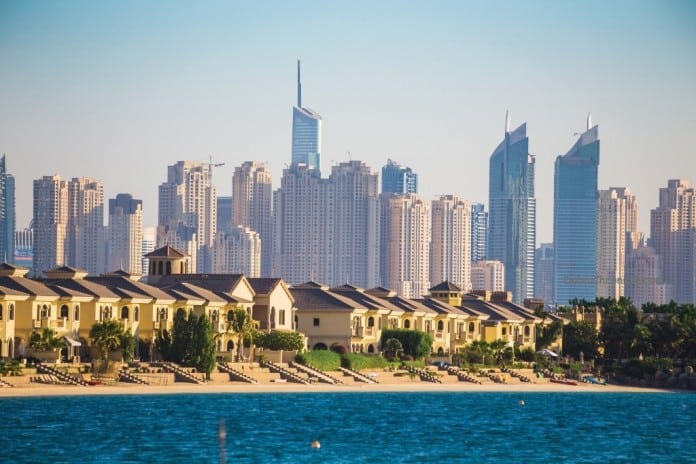
Prices and rents extend decline but select communities buck the trend
- Average apartment prices in Dubai declined by 15% between Q4 2018 and Q4 2019 and villa/townhouse prices were lower by 18%.
- Total number of transfers in Q4 2019 was 12,444 for both apartments and villas/townhouses with off-plan transfers dominating during the period.
- Over 50,000 new units will hit the market in 2020, with apartments making up majority of supply.
Cavendish Maxwell, a leading property consultancy and chartered surveying firm in the Middle East, released its 2019 UAE Property Market Report, containing key data and trends for Dubai, Abu Dhabi and the Northern Emirates. The report provides comprehensive insights on the health of the UAE’s property market, covering the residential, commercial, retail, hospitality and industrial sectors. The report was compiled by the firm’s in-house Strategic Consulting and Research team, drawing on proprietary data from its real estate intelligence platforms and in collaboration with its extensive client and partner portfolio.
Commenting on the report, Aditi Hariharan, Associate Partner, Strategic Consulting and Research at Cavendish Maxwell, said: “We step into the new year after a period of prolonged softness in prices and rents primarily driven by oversupply. However, tangible measures have now been taken to curb oversupply, including the formation of the Higher Committee for Real Estate Planning and developers holding back on new launches and focusing on projects under construction instead.
“Whilst we will still see increased handovers as developers fulfill past commitments, most projects are expected to be completed in preparation for Expo 2020, which begins in October. Within the first half the year, we expect over 50,000 units of residential supply to enter the market as developers hand over projects delayed in 2019, which could exert downward pressure on prices. Further cues are awaited from the much-anticipated Expo and any further government policy changes.”
Zhann Jochinke, Chief Operating Officer of Property Monitor said: “Many buyers who were potentially on the fence regarding property purchase decisions have decided to enter the market, as reflected by the record transaction figures in 2019. Whilst this is a strong indicator of hitting a floor in terms of prices, other indicators such as high vacancy rates and the expected upcoming supply are yet to show signs that support stabilisation. Looking ahead to 2020, the Expo is going to be a key indicator of where we stand in terms of demand and supply.”
Key market insights
The 2019 UAE Property Market Report from Cavendish Maxwell revealed several key insights and trends during the year and specifically the last quarter.
Average apartment prices declined by 15% over the 12-month period from Q4 2018 to Q4 2019 and villa/townhouse prices were lower by 18%. Whilst supply remains the primary driver for price declines, some locations have started to show signs of stabilisation, and even recovery. Softening prices spurred an increased number of property transactions in 2019, with November marking one of the strongest months in the past decade. Off-plan transfers continued to dominate in Q4 2019, accounting for more than 60% of total transfers. The total number of transfers in this period was 12,444 for both villas/townhouses and apartments.
In Abu Dhabi, the residential market performed slightly better with average apartment sales prices declining in major investment zones by 13% and villas by an even lower 11% between Q4 2018 and Q4 2019. Market conditions in the Northern Emirates remained largely like the previous quarters, with few areas displaying signs of stabilisation.
Office rents in Dubai and Abu Dhabi extended declines from the previous quarters with landlords settling on lower net effective rates whilst providing incentives to raise or retain occupancy levels. In the Northern Emirates, office rates largely remained unchanged from Q3 with only some areas displaying a marginal decrease in rents.
Retail rents in Dubai in Q4 2019 remained similar to the previous quarters, despite new supply entering the market such as Nakheel Mall, Festival Plaza and The Dubai Mall Zabeel. Majid Al Futtaim marked its entry into Abu Dhabi with its 18,500 sq m mall, My City Centre Masdar. In the Northern Emirates, a spate of new malls and mall expansions opened including The Safari Mall in Sharjah, City Centre Ajman and the Grove Village in Ras Al Khaimah.
Occupancy declined on a yearly basis across hotel categories in Dubai barring the Upper Midscale segment. Average Daily Rate (ADR) and Revenue Per Available Room (RevPAR) were also lower over the year across categories, with increased supply being the prime driver of declines. In Abu Dhabi, events such as the Special Olympics, AFC Asian Cup 2019, and Abu Dhabi Showdown Week were key drivers of visitor numbers, which led to a corresponding increase in occupancy levels in the emirate. Dubai is likely to see additional hotel supply this year as the emirate gears up to accommodate the expected 25 million visitors during the six-month Expo. Abu Dhabi is also likely to witness a spill over of Expo visitors, providing a boost to occupancy levels.
There were numerous landmark policy changes in 2019, including the ‘Golden Card’ long term residency visa and the opening of Abu Dhabi’s residential market to freehold investors, both of which were introduced to boost investor confidence and spur investments. Along with Expo 2020, these changes are likely to have a significant positive impact on the economy for years to come.




































